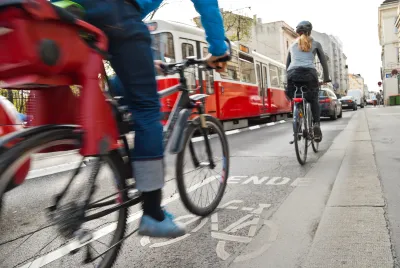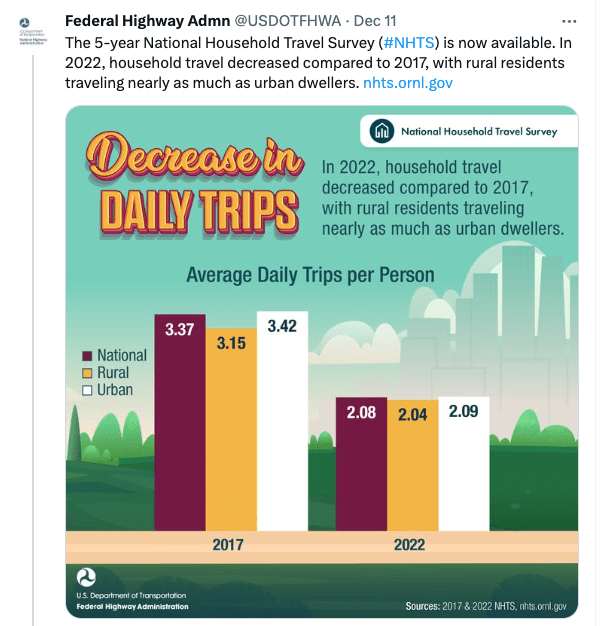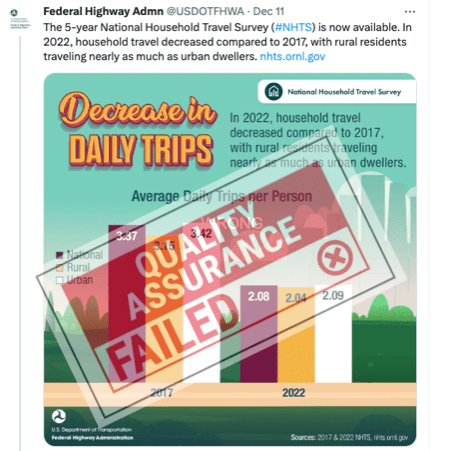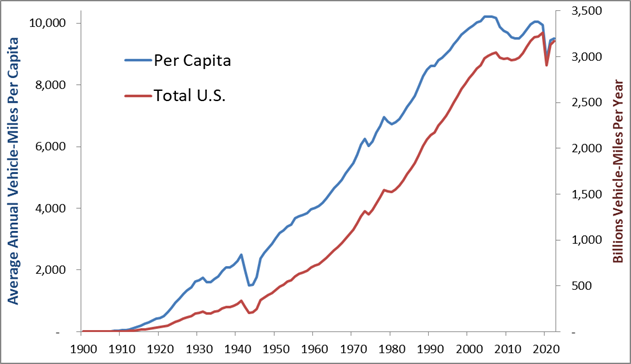There is evidence that automobile travel is peaking while demand for non-auto modes is growing, but double-check your data sources to be sure.

The National Household Travel Survey (NHTS) is a detailed study of travel activity sponsored by the U.S. Department of Transportation. Results of the 2022 version were recently released, including the following graph which shows a huge (38%!) decline in average trips per capita by all modes.

This was cited as proof of peak car and an overall decline in out-of-home activities in Angie Schmitt’s recent article, Nobody's Leaving the House Anymore.
However, as Joe Cortright points out in Bad Data: Not a Decline in Travel, this probably reflects major changes in the survey methodology (previous versions relied on a travel diary in which participants recorded their travel activity when it happened, the 2022 version had them recall trips they made the previous day, a much less reliable method) rather than actual changes in travel activity. Joe provided the following image.

However, other, more reliable data sources also indicate that per capita automobile travel is peaking while demand for other modes is increasing, as discussed in my report, The Future Isn't What It Used to Be: Changing Trends and Their Implications for Transport Planning. This reflects a combination of factors including vehicle travel saturation, aging population, rising fuel prices, increased urbanization, changing consumer preferences, improved accessibility options (such as telework, work-at-home and e-bikes) and more multimodal transportation. Automobile travel will not disappear, but it indicates that many people would prefer to spend less time and money on driving, and rely more on walking, bicycling and public transportation, provided they are convenient, comfortable and affordable.
In fact, per capita vehicle travel peaked in the US in 2006 and has declined somewhat since, as illustrated in the following graph.
U.S. Annual Vehicle Travel (FHWA)

Our regional travel surveys here on Southern Vancouver Island shows similar trends. Per capita automobile travel peaked about 2006 and subsequently declined, particularly in communities that improved non-auto travel options. Similar reductions are occurring in other North American communities.

This is good news overall. It indicates that given better options travelers will drive less and rely more on non-auto modes, helping to achieve sustainable transportation goals including local economic development, increased affordability, improved public fitness and health, and environmental protection.

National Parks Layoffs Will Cause Communities to Lose Billions
Thousands of essential park workers were laid off this week, just before the busy spring break season.

Retro-silient?: America’s First “Eco-burb,” The Woodlands Turns 50
A master-planned community north of Houston offers lessons on green infrastructure and resilient design, but falls short of its founder’s lofty affordability and walkability goals.

Delivering for America Plan Will Downgrade Mail Service in at Least 49.5 Percent of Zip Codes
Republican and Democrat lawmakers criticize the plan for its disproportionate negative impact on rural communities.

Test News Post 1
This is a summary

Test News Headline 46
Test for the image on the front page.

Balancing Bombs and Butterflies: How the National Guard Protects a Rare Species
The National Guard at Fort Indiantown Gap uses GIS technology and land management strategies to balance military training with conservation efforts, ensuring the survival of the rare eastern regal fritillary butterfly.
Urban Design for Planners 1: Software Tools
This six-course series explores essential urban design concepts using open source software and equips planners with the tools they need to participate fully in the urban design process.
Planning for Universal Design
Learn the tools for implementing Universal Design in planning regulations.
EMC Planning Group, Inc.
Planetizen
Planetizen
Mpact (formerly Rail~Volution)
Great Falls Development Authority, Inc.
HUDs Office of Policy Development and Research
NYU Wagner Graduate School of Public Service





























